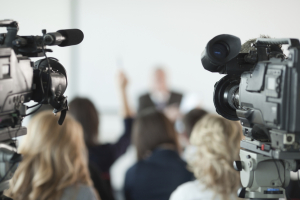-
.
Displaying items by tag: media training
BAFTA-Winning Production Insights for Better Business Presentations
In our years as BAFTA Award-winning television producers, we learned countless lessons about what makes content truly compelling. These weren't abstract creative principles—they were practical techniques refined through the unforgiving standards of broadcast television.
Now, working with business professionals at The Presenter Studio, we've discovered something valuable: the production insights that earned us industry recognition translate directly into more effective business presentations.
Here are the key lessons from behind the camera that can transform what you do in front of an audience.
Insight 1: Pre-Production Determines Success
In television, there's a saying: "Fix it in pre-production, not in post-production."
When we were producing BAFTA-winning content, we spent weeks planning before a single frame was filmed. We knew exactly what story we were telling, what shots we needed, what questions we'd ask, and how pieces would fit together.
The actual filming? That was just executing a carefully designed plan.
Amateur productions do the opposite. They start filming and hope to "find it in editing." The results are always weaker, no matter how much time they spend in post-production trying to rescue poorly planned content.
How this applies to business presentations:
Most business presentations fail during preparation, not delivery. People start building slides before they've clarified their core message. They haven't thought about their audience's perspective. They haven't structured their narrative arc. They're hoping to "fix it" during delivery or with impressive visuals.
At The Presenter Studio, we teach a pre-production approach to presentations:
- Define your exact objective. What specific action or decision do you want from this presentation? (In TV, we'd call this knowing your story.)
- Understand your audience deeply. What do they care about? What are their concerns? What's their knowledge level? (This is audience research—critical in television.)
- Structure your narrative. What's your opening hook? What's your core argument? What evidence supports it? What's your closing call to action? (This is your production outline.)
- Plan your key moments. Which three points absolutely must land? Where will you slow down? Where will you speed up? (These are your "money shots.")
Only after this pre-production work should you build slides or practice delivery.
We've seen executives transform their presentation effectiveness simply by applying television-level pre-production discipline. The content often stays similar, but it's now structured for maximum impact instead of random information delivery.
Insight 2: The First 30 Seconds Are Everything
In television, we obsessed over openings. We knew that if we didn't hook viewers in the first 30 seconds, they'd change the channel. No second chances.
This led to a specific discipline: every piece of content had to open with something immediately interesting. A provocative statement. A compelling visual. An intriguing question. A surprising fact.
We never opened with context or setup or background. We opened with the most interesting thing we had, then provided context after we'd earned attention.
How this applies to business presentations:
Most business presentations open terribly.
"Good morning everyone. Thanks for joining. Today I'll be covering three topics. First, some background on the project. Then we'll look at methodology. Finally, we'll review findings."
This is the equivalent of a TV show opening with: "Welcome to this documentary. In the next hour, we'll explore several themes related to our topic. Let's begin with some historical context."
No one would watch past the first 15 seconds.
Here's what we teach instead, using our broadcast production approach:
Open with your most compelling point. The surprising finding. The bold recommendation. The provocative question. The specific benefit to your audience.
Example transformation:
Before: "Thanks for being here. Today I'm going to present Q3 results and discuss strategic implications for the coming quarter."
After: "Our customer acquisition cost dropped 47% this quarter. That's not a typo - forty-seven percent. Let me show you exactly how we did it and why this changes everything about our growth strategy."
Which would you pay attention to?
Insight 3: Show, Don't Tell (Literally)
Television is a visual medium. One of the first things you learn in production is: if you can show it, show it. Don't have someone describe a beautiful location—show the location. Don't have someone explain how something works—show it working.
During our BAFTA-winning projects, we spent enormous effort finding ways to visualize complex information. Abstract concepts became concrete demonstrations. Data became graphics. Explanations became sequences.
Not because it looked pretty. Because visual information is processed 60,000 times faster than text, and is remembered far longer.
How this applies to business presentations:
Business presentations are typically text-heavy. Slides full of bullet points. Speakers reading information that audiences could read faster themselves.
This is the opposite of television's "show, don't tell" principle.
When we work with executives at The Presenter Studio, we push them toward visual demonstration:
- Instead of listing benefits, show a before-and-after comparison
- Instead of describing a process, walk through a specific example
- Instead of presenting data in tables, create a simple visual that reveals the pattern
- Instead of explaining a concept, demonstrate it with a prop or analogy
One client was presenting a complex operational efficiency improvement. His original presentation was 30 slides of process flows and data tables. We helped him restructure around three specific examples that demonstrated the improvement in action. Same information, radically different impact.
The television producer's instinct - "How can we show this instead of telling it?" - transforms presentations.
Insight 4: Pacing Is an Active Choice, Not an Accident
In television editing, pacing is deliberate. Fast cuts create energy and excitement. Slow sequences create tension or allow emotional moments to breathe. The best productions vary pacing strategically—moments of intensity followed by moments of reflection.
When we were producing award-winning content, we'd spend hours in editing adjusting pace. A few seconds here or there completely changed how content felt.
Pacing wasn't something that "just happened." It was crafted.
How this applies to business presentations:
Most business presenters have one pace: steady and moderate. They move through all content at roughly the same speed, regardless of what they're covering.
This is exhausting for audiences. It's like watching a film where every scene has identical pacing—no variation, no rhythm, no dynamic range.
We teach television-style pacing variation:
- Speed up through background information and context
- Slow down dramatically for your key points
- Pause completely after important statements
- Pick up pace when telling stories or examples
- Decelerate as you approach your conclusion
One technique we borrowed directly from television editing: the "two-beat pause." After delivering your most important point, pause for two full beats (roughly two seconds). This feels uncomfortably long when you're presenting. It's perfect for your audience—giving them time to absorb what you just said.
In television, we'd hold on a significant visual for those extra beats. In presentations, you hold in silence. Same principle, same impact.
Insight 5: Technical Quality Affects Credibility
Here's something we learned producing for BAFTA consideration: technical quality isn't just aesthetic. It affects how seriously audiences take your content.
Poor audio makes viewers question content quality. Bad lighting makes even compelling stories feel amateurish. Shaky camera work undermines credibility.
This isn't shallow. It's psychological. Audiences unconsciously use production quality as a proxy for content quality.
How this applies to business presentations:
When you're on video calls with poor lighting and bad audio, audiences unconsciously perceive you as less credible and less senior—regardless of what you're saying.
When your slides are cluttered and amateur-looking, people doubt the quality of your thinking.
When your physical presence is low-energy, audiences assume your ideas lack energy.
At The Presenter Studio, we apply television production standards to business presentations:
For video presence:
- Invest in basic lighting (even a £30 ring light transforms presence)
- Use a good microphone (laptop mics undermine credibility)
- Frame yourself properly (learn the rule of thirds from photography)
- Create an uncluttered background (or use tasteful blur
The Evolution of Presenter Training: From TV Studios to Corporate Stages
Twelve years ago, when we founded The Presenter Studio as BAFTA Award-winning television producers, our mission was clear: train the next generation of TV presenters.
We'd spent years in television production, working with celebrity talent and creating broadcast content. We knew what made someone compelling on screen. We understood the specific skills that separated good presenters from great ones.
Our first clients were exactly who we expected: people with dreams of television careers. Aspiring presenters who wanted to break into broadcasting. Actors who needed stronger on-camera skills. People who'd been told they had "screen presence" and wanted to develop it professionally.
We loved this work. Television was our world, and we were passing on hard-won expertise from our BAFTA-winning production careers.
Then the industry started shifting beneath our feet.
The First Pivot: When TV Started Changing
Around 2015, we began noticing something concerning. The television industry—particularly traditional broadcasting—was contracting. Streaming was rising. YouTube was creating new types of presenters. The pathway into television presentation was becoming less clear.
Meanwhile, our phones started ringing with different types of calls.
"We saw your TV presenter training," a corporate communications director said. "Could you teach our executives those skills?"
Initially, we were hesitant. We were television professionals, not business trainers. Would our expertise even translate?
We decided to experiment. We brought a senior leadership team through a modified version of our TV presenter training—on-camera techniques, message clarity, vocal variety, purposeful movement.
The results surprised us. These executives weren't preparing for television, but the skills transformed how they presented to their boards and teams. One participant later told us: "I've been presenting for twenty years, but no one ever taught me these techniques. This changed everything."
We started to realize something important: the skills that make TV presenters effective aren't specific to television. They're fundamental communication skills that work everywhere.
Understanding the Problem
As we worked with more corporate clients, we identified the core issue they faced.
Business professionals are often brilliant strategists, subject matter experts, and decision-makers. They have important things to say. But they'd never been taught how to deliver those messages compellingly.
They'd learned public speaking in school (maybe), picked up some presentation tips from colleagues, and mostly just figured it out as they went along. The result? Competent but forgettable presentations. Information delivered but not remembered. Good ideas that didn't get buy-in because the delivery didn't match the quality of the thinking.
Meanwhile, TV presenters receive extensive training in exactly these skills. They learn how to structure messages for impact, use their voice as an instrument, command attention, handle pressure, and connect with audiences.
Why shouldn't business professionals have access to that same expertise?
The Second Wave: Video Becomes Unavoidable
Around 2018-2020, video communication exploded in business. What had been occasional conference calls became daily video meetings. What had been rare media interviews became regular social media presence.
Suddenly, every executive was on camera constantly—but almost none of them had on-camera training.
This is when we saw the real value of our television production background. We'd spent years understanding what works on screen versus in person. We knew the specific adjustments people need to make for camera presence. We understood lighting, framing, energy projection through a lens, and where to direct your gaze.
These weren't abstract concepts from our TV days—they were immediately practical skills that every professional needed.
Our corporate training evolved again. Now we weren't just teaching presentation skills. We were teaching broadcast-level on-camera performance for business contexts.
What We Kept from Our TV Roots
As we evolved from training TV presenters to training business professionals, we realized certain elements of our approach were universally valuable:
High Standards In television production, there's no room for "pretty good." Content either works or it doesn't. We brought those same standards to corporate training. We don't accept mediocre presentations just because someone is "not naturally a presenter." We expect excellence because we know it's achievable.
Specificity TV training is concrete. "Make eye contact with the camera lens for three seconds." "Pause for two beats after your key message." "Lower your vocal pitch at the end of statements." We don't deal in vague advice like "be more confident." We teach specific, actionable techniques.
Practice Under Realistic Pressure TV presenters don't just talk about performing under pressure—they practice it repeatedly. We brought this same approach to corporate training. Our clients present on camera, get feedback, and present again. They practice recovery when things go wrong. They build muscle memory for techniques.
Focus on Authenticity The best TV presenters aren't performers in the theatrical sense. They're authentically themselves, just optimized. We never try to turn people into something they're not. We help them become the most effective version of themselves.
What We Added for Corporate Clients
Working with business professionals also taught us new elements that now define our approach:
Business Context Understanding We had to learn the specific scenarios our clients face. Board presentations operate differently than investor pitches. Team meetings require different skills than media interviews. We studied business communication the way we once studied television formats.
Integration with Business Strategy Unlike aspiring TV presenters who needed general skills, executives needed presentation training that supported specific business objectives. We learned to connect communication skills with strategic outcomes.
Scalability Television typically trains individuals. Businesses needed us to train teams, develop internal capability, and create lasting change across organizations. We built programs that could scale while maintaining quality.
Measurement of Impact Business clients rightfully asked: "What's the ROI?" We developed ways to measure improvement and connect presentation skills to business results—something we'd never needed to do in television.
Where We Are Now
Today, The Presenter Studio serves primarily corporate clients, but our identity remains rooted in our television production heritage. We're still BAFTA Award-winning producers who've worked with celebrities and created broadcast content.
That background is our competitive advantage.
When we teach an executive how to handle difficult questions, we're drawing on years of managing celebrity interviews and media incidents. When we coach someone on on-camera presence, we're applying techniques refined through countless hours of television production. When we help someone tell a compelling story, we're using narrative principles from our BAFTA-winning work.
We're not business consultants who added presentation training to their services. We're television professionals who discovered that broadcast-level communication skills are exactly what business leaders need.
The Unexpected Benefit of Our Evolution
Here's something we didn't anticipate: working with corporate clients made us better at what we do.
In television, you can succeed with strong technical skills. But in business, we had to deeply understand why these techniques work. We had to be able to explain the psychology of attention, the neuroscience of storytelling, and the mechanics of credibility.
Teaching executives—many of them skeptical about "presentation training"—forced us to become more precise, more practical, and more results-focused.
Now when we do train aspiring TV presenters (we still work with some), we're actually better at it than we were twelve years ago because we understand the underlying principles more deeply.
What the Next Twelve Years Might Hold
We're now watching new shifts in how people communicate. Virtual reality presentations. AI-generated content. New platforms we can't yet imagine.
But we've learned something important from our journey: the fundamentals of effective human communication remain constant even as mediums change.
Whether you're presenting on television, in a boardroom, on a video call, or in whatever medium emerges next, you still need to:
- Capture and hold attention
- Deliver messages clearly
- Connect authentically
- Project credibility
- Handle pressure gracefully
- Tell compelling stories
These skills transcend any specific platform. They're human skills, not technical skills.
That's why we're confident The Presenter Studio will remain relevant regardless of how communication technology evolves. We teach fundamentals that have been valuable for as long as humans have been communicating, refined through the demanding standards of professional television production.
The Bottom Line
We didn't plan to evolve from TV presenter training to corporate presentation skills. The market pulled us in this direction because business professionals recognized the value of broadcast-level communication training.
Looking back, we're grateful for how things unfolded. We get to use our BAFTA-winning television production expertise to create real business impact. We help executives become more effective leaders, companies communicate more powerfully, and professionals advance their careers.
We're still television people at heart. We still think like producers, train like we're preparing someone for broadcast, and maintain the high standards that won us awards.
But now we apply that expertise where it can make the biggest difference: helping business professionals communicate with the same skill and impact as the best television presenters.
And honestly? That feels like exactly the right evolution.
The Presenter Studio brings 12 years of evolution and BAFTA-winning television expertise to corporate presentation training. Discover how broadcast-level skills can transform your business communications.
Why TV Presenter Skills Matter in the Boardroom
When we founded The Presenter Studio 12 years ago as BAFTA Award-winning television producers, our focus was training aspiring TV presenters. We taught autocue reading, camera presence, and broadcast delivery techniques.
Then something interesting happened. Corporate executives started approaching us.
"Can you teach us what you teach TV presenters?" they'd ask. "We need to present to boards, investors, and large teams. We need to be as compelling as people on television."
Initially, we weren't sure our TV expertise would translate. We were wrong. It translates perfectly. Here's why television presenter skills have become essential for business success.
The Attention Economy Hit Business Hard
Television presenters have always competed for attention. Change the channel and they're gone. They learned to be compelling within seconds or lose their audience.
Now business presenters face the same challenge. Your board members have phones buzzing with notifications. Your team is on video calls with email open in another window. Your investors are evaluating multiple opportunities simultaneously.
The skills TV professionals use to capture and hold attention—strong openings, strategic pauses, vocal variety, purposeful movement—aren't just nice to have anymore. They're essential for ensuring your message even gets heard.
Video Is Now the Default Communication Medium
Remember when "presenting" meant standing in a conference room with slides? Those days are gone.
Now you're on Zoom calls, recording video messages, appearing in company broadcasts, and maybe even doing media interviews or conference speaking. You're on camera constantly—just like a TV presenter.
Yet most businesspeople never learned on-camera skills. They don't know where to look, how to frame themselves, or how to project energy through a lens. TV presenters master these skills as fundamentals. Business professionals need them just as urgently.
Through our work at The Presenter Studio, we've seen countless executives transform their video presence by applying simple broadcast techniques—proper camera positioning, energy projection, and the specific eye contact patterns that work on screen versus in person.
Authenticity Has Become a Competitive Advantage
Here's an interesting paradox: TV presenters are trained performers, yet the best ones seem completely authentic. How?
They've learned to be genuinely themselves while optimizing their delivery. They know how to eliminate distracting habits without becoming robotic. They understand how to project their authentic personality in a way that translates through cameras and reaches audiences.
Business leaders face the same challenge. Stakeholders are sophisticated. They can spot inauthentic corporate speak immediately. Yet completely unrehearsed presentations often ramble or miss key messages.
The solution? The TV presenter's approach: deep preparation that allows for authentic delivery. Know your message so thoroughly that you can deliver it conversationally. This is exactly what we teach in our corporate presentation training.
Storytelling Has Moved from "Nice to Have" to "Must Have"
Television professionals understand something fundamental: facts alone don't persuade. Stories do.
A TV documentary doesn't just present information. It takes you on a narrative journey with tension, resolution, and emotional connection. This isn't manipulation—it's how human brains process and remember information.
Business presentations increasingly require the same approach. Investment pitches need narrative arc. Change management communication needs emotional resonance. Strategy presentations need to take audiences on a journey.
We've worked with CEOs who had brilliant strategies but couldn't get buy-in. The problem wasn't their thinking—it was their presentation. Once we applied storytelling techniques from our BAFTA-winning television production background, those same strategies suddenly became compelling. The content hadn't changed. The delivery had.
Recovery Under Pressure Is a Daily Requirement
TV presenters work with the knowledge that anything can go wrong—teleprompters fail, guests don't show up, technical issues arise—and they must handle it gracefully while maintaining credibility.
Business leaders face similar pressures. A key slide doesn't load. Someone asks a hostile question. The presentation time gets cut in half. A crisis emerges mid-meeting.
The executives who handle these moments well share something with professional broadcasters: they've trained for recovery. They have techniques for maintaining composure, pivoting smoothly, and turning problems into opportunities to demonstrate competence.
This is why we incorporate "crisis scenarios" into our corporate training. We learned from years of television production that you can't train someone to "stay calm under pressure" with advice alone. You need to create realistic pressure situations and practice recovery techniques until they become automatic.
Personal Brand Now Matters for Everyone
TV presenters have always understood that they are their brand. Their credibility, trustworthiness, and likability directly impact their career success.
This reality has now extended to business professionals. Your presentation style shapes how you're perceived as a leader. Your video presence influences whether people trust your judgment. Your ability to communicate vision determines whether teams follow you.
We've seen talented executives plateau in their careers not because they lack strategic thinking, but because they lack presentation skills. They're perceived as less confident, less visionary, or less credible than they actually are—simply because they never learned on-camera techniques.
Meanwhile, others accelerate their careers by mastering these skills. They're the same person with the same capabilities, but now they're perceived differently because they present differently.
The Skills Are Learnable (Not Innate)
Here's the most important thing we've learned training both TV presenters and business professionals over 12 years: these skills are completely teachable.
People assume TV presenters are naturally charismatic or comfortable on camera. They're not. They've been trained in specific techniques—where to look, how to modulate their voice, how to use gestures purposefully, how to structure content for impact.
When we teach these same techniques to executives, they develop the same capabilities. The CFO who seemed stiff becomes compelling. The technical director who rambled becomes clear and concise. The CEO who struggled with credibility starts commanding rooms.
The difference between an effective presenter and an ineffective one isn't talent. It's training.
What This Means for Your Organization
If your business requires people to present - to boards, investors, clients, teams, or the public - then TV presenter skills are no longer optional professional development. They're core business skills.
The executives who present well get buy-in for their ideas. They inspire their teams. They represent your organization credibly. They advance their careers and contribute to organizational success.
Those who present poorly - even if they're brilliant strategists - struggle to get ideas heard, teams engaged, or stakeholders convinced.
At The Presenter Studio, we've built our entire methodology around translating professional broadcast techniques into practical business applications. We know these skills matter because we've seen the career and organizational impact when people master them.
The Bottom Line
The lines between television presentation and business presentation have dissolved. You're on camera regularly. You compete for attention constantly. You need to be authentic, compelling, and credible under pressure.
These were always requirements for TV presenters. Now they're requirements for business success.
The good news? Everything TV professionals know about effective presentation is learnable. You don't need natural charisma or performance background. You need the right training from people who understand both broadcast excellence and business context.
That's exactly what we provide.
Ready to bring television-level presentation skills to your business? The Presenter Studio's BAFTA-winning team specializes in translating broadcast techniques into corporate impact.
Media Training for Business Leaders: How to Shine on Camera and Off
Media exposure is no longer the reserve of celebrities; business leaders must communicate effectively to shape perception and drive results.
Media training equips leaders to protect their brand, enhance credibility, and present with confidence in both public and virtual settings.
Key skills include handling difficult questions, speaking concisely and clearly, engaging audiences through storytelling, and mastering non-verbal communication.
Leaders should practice key messages, maintain eye contact with interviewers, and ensure that their delivery reflects both authority and authenticity.
With the right training, executives can navigate interviews, presentations, and on-camera appearances with confidence.
The Presenter Studio offers media training specifically designed for business leaders to build credibility and presence in all communication settings.
How Media Training Prepares You for Tough Interviews
One of the hardest parts of dealing with the media is handling tough or unexpected questions in interviews. Even the most experienced professionals can be caught off guard. Media training equips you with the techniques to stay composed and in control.
You’ll learn bridging strategies to guide the conversation back to your key messages, without sounding evasive. Training also helps you develop concise soundbites — short, memorable answers that resonate with audiences and are more likely to be quoted.
Perhaps most importantly, media training builds resilience. Instead of fearing challenging interviews, you’ll see them as opportunities to demonstrate authority and transparency. When you know how to prepare, you’ll never be left speechless.
For professional guidance, visit: https://www.presenterstudio.com/business-presenter-training/media-training
The Top Benefits of Media Training for Your Career
Media appearances are opportunities — not just to inform, but to inspire trust and build your profile. Yet many professionals fear interviews because they don’t know how to prepare. This is where media training comes in.
One of the biggest benefits is learning how to simplify complex information. Journalists and audiences want clarity, and media training helps you strip away jargon so your message lands. Another advantage is learning how to stay on track, even if the interviewer tries to push you in a different direction.
Confidence is another outcome. With practice in front of the camera, you’ll learn to project authority and remain calm, even when the pressure is high. These skills don’t just help in interviews — they carry over into presentations, boardrooms, and everyday communication.
To learn more, visit: https://www.presenterstudio.com/business-presenter-training/media-training
Why Media Training is Essential for Professionals
In today’s fast-paced media landscape, knowing how to communicate effectively on camera or in interviews is more important than ever. Whether you’re a business leader, spokesperson, or expert in your field, your ability to handle the media can shape your reputation.
Media training helps you master key skills, such as controlling your message, handling difficult questions, and speaking with confidence under pressure. It also teaches you how to look natural on camera and use body language to reinforce your words.
Without proper preparation, even the most knowledgeable professionals can appear nervous, evasive, or unconvincing. That’s why organisations invest in media training to protect their brand and ensure their people make a strong impression.
For more information on professional training, visit: https://www.presenterstudio.com/business-presenter-training/media-training
How Media Training Prepares You For Tough Questions
Difficult questions are inevitable in interviews, but how you respond defines your credibility. Media training prepares you to deal with these moments calmly and effectively. One strategy is to pause briefly before answering. This prevents rushed responses and gives you a chance to choose words carefully. Another technique is to acknowledge the question while steering towards your key message. For example, you can address concerns directly but then explain the positive actions your business is taking. Training also helps you avoid common pitfalls such as speculation, jargon, or defensive reactions. Practising under pressure makes it easier to stay composed when cameras are rolling. Most importantly, media training shows you how to remain authentic, so your responses build trust rather than raise suspicion. These skills are essential for protecting your reputation and turning a challenging moment into an opportunity.
For tailored training programmes that prepare you for every interview visit https://www.presenterstudio.com/business-presenter-training/media-training
Top Tips You Learn From Media Training
Media training is full of practical tools that you can use immediately. One of the first tips is to always keep your answers short and clear. Long-winded responses can easily be edited or misinterpreted, while concise soundbites get quoted. Another tip is to bridge back to your main message. Journalists may ask difficult questions, but you can still find a way to guide the conversation towards the key point you want to land. A third tip is to control your body language. Sit or stand tall, use open gestures, and maintain steady eye contact. Another valuable tip is to practise under realistic conditions. Training often includes mock interviews which simulate real pressure, helping you build confidence. Finally, remember to be authentic. Audiences respond to honesty and personality, not robotic or rehearsed answers. Media training gives you the space to practise and refine these skills until they feel natural.
For expert coaching in handling the media visit https://www.presenterstudio.com/business-presenter-training/media-training
Why Media Training Is Essential For Business Leaders
In today’s fast-moving media landscape, interviews and press opportunities can make or break a reputation. Media training equips business leaders with the skills to handle these situations with confidence. It is not enough to know your subject matter. You also need to know how to deliver your message in a way that is clear, concise, and memorable. Media training teaches you to stay on message even under pressure, to respond to difficult questions with authority, and to project credibility in every appearance. The ability to manage tone, body language, and soundbites ensures that your audience remembers the key points you want to highlight rather than being distracted by nerves or missteps. For leaders looking to strengthen their brand and protect their organisation’s reputation, media training has become an essential tool rather than a luxury.
For more information on professional coaching visit https://www.presenterstudio.com/business-presenter-training/media-training











